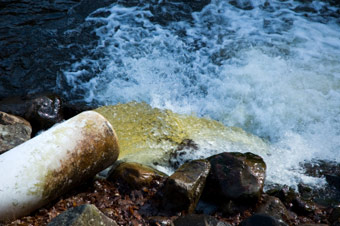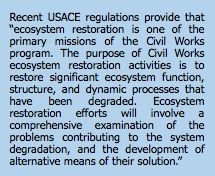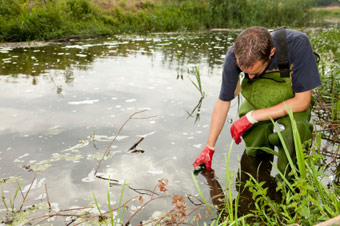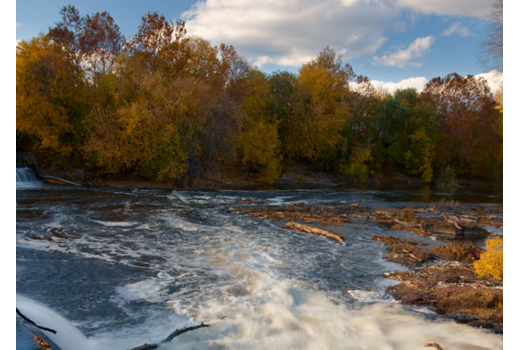Cooperative River Restoration for Long-Term Urban Sustainability
Dozens of major rivers flowing through highly urbanized areas across the United States suffer from high pollution levels. While industrial effluents, municipal waste discharges, urban run-off and other sources of urban waste have been reduced in some areas in recent years, severely contaminated sediments in many rivers still pose major risks to aquatic life and limit recreational and economic use.
The extent of the contaminated sediment problem in our Nation is striking. In its 2004 report, The Incidence and Severity of Sediment Contamination in Surface Waters of the United States, National Sediment Water Quality: Second Edition1, the Environmental Protection Agency (EPA) reported that at least 96 urbanized U.S. watersheds each contain 10 or more sediment sampling stations showing that “adverse effects on aquatic life or human health are probable.” Threats cited in EPA’s 1998 Contaminated Sediment Management Strategy2 include possible juvenile neurological and IQ impairment from food chain poisoning, increased incidence of cancer, and long-term damage to aquatic ecosystems.
Past Solution Attempts
Past attempts to address the problem of contaminated sediments have had only limited success. The most notable are those through the Federal Superfund program. Unfortunately, however, the Superfund program, which was designed for land-based contaminated sites, sometimes does not fit well with aquatic environments.

© iStockphoto.com/clagge
Typically in aquatic environments contaminated sediment problems cover large geographical areas, involve many chemicals and a large number of dischargers (sometimes thousands and, when municipalities are included, millions), and often reflect a long history of contamination (often exceeding a century). The Superfund program, on the other hand, is best applied to relatively small, well-defined areas with clear relationships between presence of contaminants and generators, transporters and disposers who put them there.
The strict, joint, several and retroactive liability provisions of Superfund, when applied to contaminated sediment problems, typically lead to a long-term litigious morass in which huge amounts of money are spent in so-called “transaction costs,” rather than being applied to actual cleanup. When one superimposes Superfund’s inability to deal with on-going pollution problems, huge stakeholder numbers and other complexities common to urban river corridors, it is easy to see why a different approach is needed.
An Alternative Approach
In response to this situation, an intergovernmental, public-private cooperative program to restore rivers affected by contaminated sediments has been underway on a relatively small scale for more than a decade. This alternative approach – the Urban Rivers Restoration Initiative – involves a cooperative effort between the U.S. Army Corps of Engineers (USACE) and EPA. To implement the program, Memoranda of Understanding (MOU) were executed in 20023, 20054 and 20065.
Under this urban river restoration program, USACE and EPA jointly conduct cooperative project planning and development processes in conjunction with state and local agencies, and other stakeholders, to identify and apply the most feasible solutions to contaminated urban rivers. Such solutions are designed to achieve environmental restoration and economic revitalization throughout degraded urban river corridors.
The new program has strong synergy with several other Federal efforts, including EPA’s Total Maximum Daily Load initiative and the brownfields redevelopment initiative. A Corps of Engineers-sponsored study of 262 brownfields redevelopment case studies, for example, found that the solution to urban river corridor water quality degradation problems is a key ingredient at 37 (14.1 percent) of the sites6. Such statistics make clear the contribution a contaminated sediment solution can make to the national redevelopment effort considering the 425,000 brownfield sites said to exist by the General Accounting Office.
USACE History in Watershed-Based Planning
It is precisely this type challenge that the Corps of Engineers, with its extensive experience in comprehensive watershed planning and multidisciplinary capabilities, is well suited to address. Under recently enacted legislative authorities, USACE now has authority to undertake single-purpose ecosystem restoration initiatives or multiple purpose projects that include ecosystem restoration as a purpose.
 These authorities enable the Corps to undertake all aspects of ecosystem protection and restoration studies and project implementation. Such broad statutory authorities, combined with USACE’s state-of-the-art expertise with recently developed analytical tools relevant to watershed-based planning (such as GIS, GPS and powerful electronic computational hardware), make conversion of the theoretical watershed approach into specific project and programmatic activities a realistic expectation.
These authorities enable the Corps to undertake all aspects of ecosystem protection and restoration studies and project implementation. Such broad statutory authorities, combined with USACE’s state-of-the-art expertise with recently developed analytical tools relevant to watershed-based planning (such as GIS, GPS and powerful electronic computational hardware), make conversion of the theoretical watershed approach into specific project and programmatic activities a realistic expectation.
In order to facilitate the new roles envisioned in these new authorities, USACE established National Ecosystem Restoration as an objective for its Civil Works planning studies. Under new Corps guidance, single purpose ecosystem restoration plans may be formulated and evaluated in terms of their contributions to increases in ecosystem values. This is consistent with a current Obama Administration effort to update the Federal government’s water resources project planning guideline document, Principles and Guidelines for Water and Land Related Resources Implementation Studies, an effort mandated by the Water Resources Development Act of 2007. The new approach calls for development of water resources projects based on sound science that maximizes net national economic, environmental and social benefits.
EPA History in Watershed-Based Planning
EPA has performed watershed planning since its founding and continues to stress the importance of integrated solutions to watershed problems. Initiatives such as watershed-based National Pollutant Discharge Elimination System (NPDES) permitting, water quality trading and the index of watershed indicators illustrate the Agency’s emphasis on watershed-based planning.
In the last decade, the Total Maximum Daily Load (TMDL) program has become a major component in watershed planning. TMDL calculates the maximum amount of a pollutant allowed to enter a water body (also known as loading capacity), so the water body will meet and continue to meet water quality standards for that particular pollutant. TMDL allocates that load to point and nonpoint sources that include man-made and natural background sources of pollutants. EPA cannot enforce implementation of TMDL. Rather, if TMDL requires more stringent permit limits for point sources, these must be implemented in appropriate NPDES permits at the time of their renewal. If TMDL identifies nonpoint sources of pollutants as a major cause of impairment, states can apply for EPA grants to fund state programs for nonpoint source assessment and control, as well as individual projects.8
Lower Passaic River, New Jersey

© iStockphoto.com/JamesBrey
While the Urban River Restoration Initiative holds promise for urban river corridors throughout the United States, to date the program has focused only on eight pilot urbanized rivers jointly chosen by EPA and USACE. One of these is northern New Jersey’s lower Passaic River located in the heart of the U.S. industrial revolution that began in the late 19th century. Since the industrial revolution’s beginning, hundreds of chemical, paint and pigment manufacturing plants, petroleum refineries and other large industrial facilities have discharged effluents into the Passaic. While many of these facilities have closed, 13 petroleum refineries and six chemical manufacturing plants are still operating. High concentrations of dioxins, mercury, lead, polychlorinated biphenyls (PCBs) and other chemicals characterize this highly degraded river system. The river also has been heavily impacted by massive regional urbanization and population growth and has been listed on EPA’s Superfund National Priority List.
More than a century of urbanization and heavy industrial use in the Passaic River Basin has resulted in extensive shoreline impacts, including an almost complete loss of tidal and freshwater wetland habitat through bulkheading and other anthropogenic structural changes. Impacts to fish and shellfish have been extensive, as have impacts to birds and mammal populations. In addition, a number of Passaic historical tributaries have been converted to storm sewer drains or filled in, and normal freshwater inflows have been replaced largely by contaminated urban run-off. Human uses, such as fishing, rowing, boating, swimming, picnicking and wildlife observation, also have been severely degraded. Other dimensional complexities include: pathogenic microbial contamination, seasonal anoxic conditions, floatable debris, excessive levels of waterborne nutrients and nonpoint source discharges.
A large number of stakeholder groups have interests in the Passaic watershed, including municipalities, environmental organizations, industries and other entities. Considerations of environmental justice also are important in the Passaic Basin, where minorities and economically disadvantaged people may be exposed disproportionately to these degraded conditions.
Need for a Watershed-Based Approach
The complex nature of the Passaic River problems, not unlike other urban rivers, makes a comprehensive watershed approach essential to successful economic revitalization and environmental restoration. The term “watershed approach” refers to an integrated perspective in water resources planning that provides a framework for integrating economic, natural and social considerations sharing the same geographic space. This framework facilitates coordination of public and private sector efforts to address the highest priority problems within hydrologically-defined geographic areas such as the Passaic River Basin.
Important elements of the watershed approach include assessment of natural, social and economic resources, interdisciplinary identification of priority problems, identification of goals and objectives, facilitation of high levels of stakeholder involvement, development of integrated solutions that make use of the expertise of multiple agencies, utilization of management techniques based on sound science and measurement of success through monitoring and other types of data collection.

© iStockphoto.com/BartCo
Under the watershed approach, appropriate agencies compare lists of high priority areas, meet with each other and additional stakeholders, and look for opportunities to leverage finite resources to meet common goals. The Lower Passaic listing on the Superfund National Priorities List – due to its contaminated sediments – complicates the watershed improvement process that needs to be implemented. As a result, it is imperative to consider a watershed approach that integrates the Superfund process into eventual mechanisms to achieve a restored Passaic River.
Why the Passaic?
The Lower Passaic River represents an excellent pilot area for demonstrating benefits of the Urban River Restoration Initiative for several reasons. First, the situation complexity, as described above, demands a comprehensive, watershed-based approach to the problem. Second, the listing of 17 miles of the Lower Passaic as a Superfund site presents significant procedural and substantive requirements. Site-specific solutions undertaken in the absence of an overall regional solution are doomed to failure no matter how well they may be designed and funded. Application of the Corps of Engineers’ experience and expertise in comprehensive watershed planning not only represents a promising solution to Passaic problems, but also is providing an excellent real-world test of this still-new approach.
Although situation complexity is intimidating, much progress is being made. For example, in July 2006 the Corps released its Lower Passaic River Restoration Project: Restoration Opportunities Report9 delineating a series of projects consistent with a Hudson Raritan Estuary Ecosystem Restoration plan also developed by USACE in conjunction with other agencies. In addition, more than six dozen private companies located in the lower Passaic River watershed invested approximately $200 million in research and planning studies and initial planning, design and construction on the River in recent years. This work provides a strong analytical foundation for identifying and evaluating restoration options.
Conclusion
Since publication of the National Research Council’s 1989 landmark report, Contaminated Marine Sediments: Assessment and Remediation10 , much has been learned about how to address contaminated urban waterways. One learning point is that remedial technologies alone will not solve the problem. Solutions must consider aspects of source reduction, natural attenuation, in-situ containment and treatment, dredging, ex-situ treatment and other technological and institutional tools. All these solution components must be considered in context of appropriate human health and ecological risk considerations, benefit-cost considerations and a host of other relevant waterway restoration factors.
With many stakeholders and regulatory programs involved in the problem, consensus building among such parties also is essential to success. It is in this environment that the cooperative approach described herein is being pursued as an alternative to approaches that rely on litigation.





























